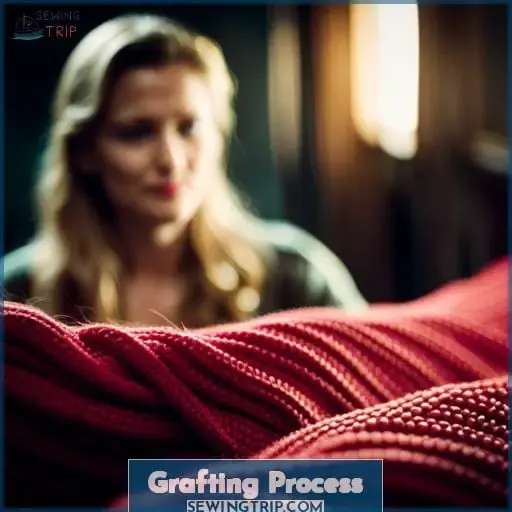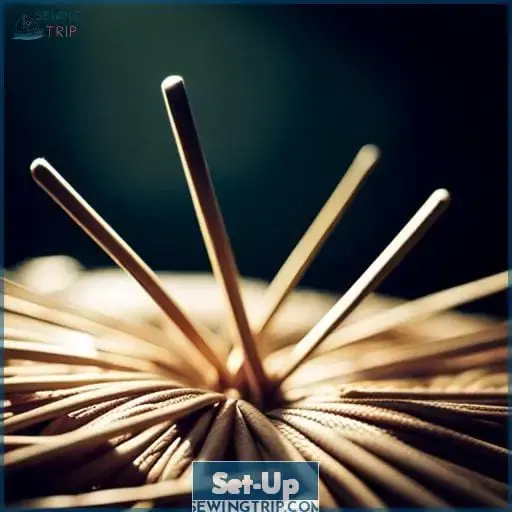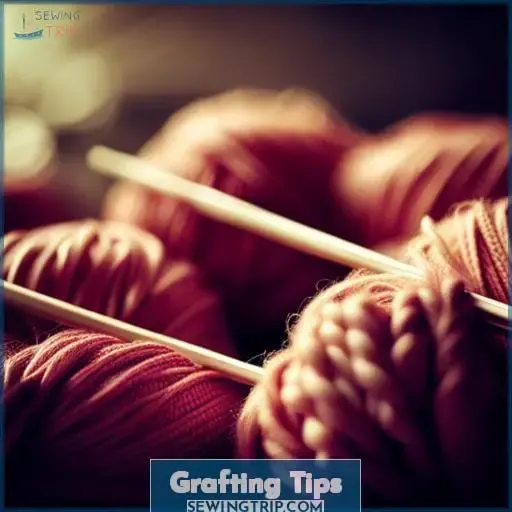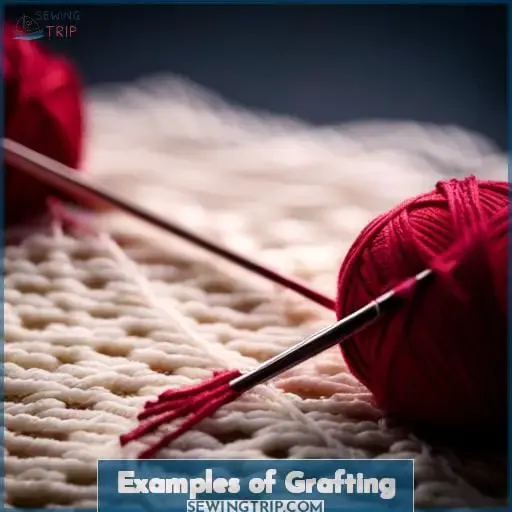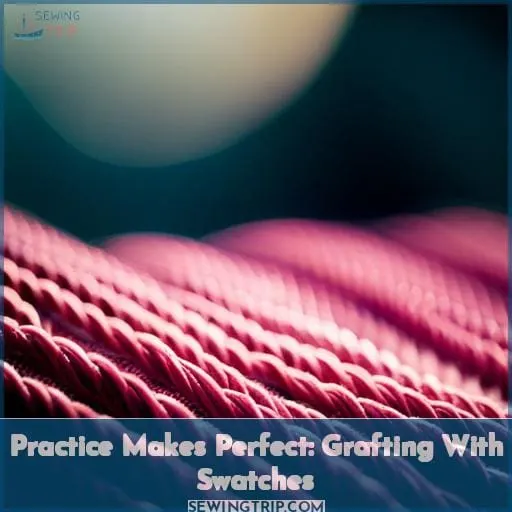This site is supported by our readers. We may earn a commission, at no cost to you, if you purchase through links.
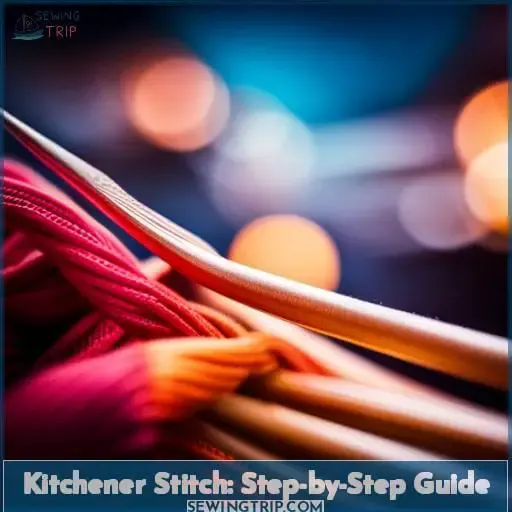 Imagine yourself seamlessly stitching together two pieces of knitting, creating a join that is practically invisible.
Imagine yourself seamlessly stitching together two pieces of knitting, creating a join that is practically invisible.
With our step-by-step guide to Kitchener Stitch, you’ll unlock the power to master this essential technique in no time.
Whether you’re a seasoned seamstress or just starting out on your crafting journey, we’ve got you covered with clear instructions and helpful tips.
Get ready to take your knitting skills to the next level as you dive into the world of Kitchener Stitch!
Table Of Contents
Key Takeaways
- Kitchener Stitch is a seamless knitting technique used for grafting live stitches together.
- It is a versatile method that can be applied to various knitting projects, such as closing sock toes and joining shoulder seams.
- Consistent practice is essential for mastering the Kitchener Stitch and achieving flawless joins.
- Proper setup, tension, and concentration are crucial for the successful execution of the grafting process.
Grafting Process
Now, let’s dive into the grafting process of the Kitchener Stitch.
Grafting involves joining live stitches seamlessly by using a darning needle and yarn.
To begin, carefully place your stitches on two needles with wrong sides facing each other, then thread your yarn onto a darning needle.
From there, you’ll follow repeated steps to create an invisible join between the front and back stitches until only one stitch remains on each needle.
Finally, weave in any loose ends for a polished finish.
Joining Live Stitches
To join live stitches using the Kitchener Stitch, start by carefully threading your darning needle and inserting it through the first front stitch as if you were purling.
Then, insert the needle through the first back stitch as if to knit.
Repeat these steps for subsequent stitches until all are worked.
This technique allows for seamless joining of stitches and is perfect for projects that require a polished finish, such as socks or garments with delicate patterns.
Repeated Steps
Now that you have joined the live stitches, it’s time to repeat the steps of the grafting process. This repeated sequence is crucial for achieving a seamless join and mastering the Kitchener Stitch technique.
Remember to maintain a rhythmic sequencing as you maneuver your needle through each stitch. The procedural flow should be consistent and precise, allowing for sequential mastery of this knitting technique.
Practice these repeated steps with focus and determination to achieve flawless results in your projects.
Completion
To complete the grafting process, perform a final set of steps to ensure all stitches are properly worked and secured. These last steps add the finishing finesse and give your project its polished look.
It’s like adding those final touches that make everything come together seamlessly.
With the help of a darning needle and your mastery of the Kitchener stitch, you can achieve a flawless grafting wrap-up for seamless knitting, especially for sock toes or other projects requiring an invisible join.
Set-Up
Prepare the set-up for grafting by dividing your stitches evenly onto two needles.
To ensure a successful start to your Kitchener Stitch, follow these steps:
- Needle Positioning:
- Place the stitches on two separate needles with wrong sides facing each other. This will allow for easy manipulation of the fabric while grafting.
- Cut a length of yarn, leaving a tail that’s at least three times the length of the section you’ll be grafting.
- Thread this yarn onto a blunt tapestry needle.
- Insert your threaded needle into the first stitch on both front and back needles in their respective positions (front as if to purl and back as if to knit).
- Take care not to cross or tangle your threads during this process.
- Make sure you have enough tail length remaining after threading it through so that you can weave in ends later without difficulty.
Now that you have completed setting up, it’s time to move on to actually performing the Kitchener Stitch!
Grafting Tips
As you continue with the process of grafting in the Kitchener Stitch, keep these helpful tips in mind:
-
Tension Mastery:
- Pay attention to your tension throughout the grafting process.
- Too tight and your join will be rigid; too loose and it will be sloppy.
- Aim for a seamless, stretchy result by practicing consistent tension.
-
Mnemonic Techniques:
- Grafting can be complex, so use mnemonic techniques to remember each step.
- Create a chant or rhyme that guides you through the knit off, purl on sequence.
3.Concentration Techniques:
- Grafting requires focus and concentration to ensure accuracy.
- Find a quiet space with good lighting where you can fully immerse yourself in this delicate task.
4.Visual Aids:
- Use visual aids such as cue cards or diagrams that illustrate each step of the Kitchener Stitch process.
- This way,you have an easy reference point if you get stuck during grafting
By incorporating these tips into your practice sessions,you’ll improve your skill level and achieve flawless joins every time!
Examples of Grafting
You can use the Kitchener Stitch to seamlessly close sock toes, join shoulder seams, and finish mitten tops. This versatile technique isn’t limited to specific applications and can be used in various creative ways.
Here are some examples of grafting using the Kitchener Stitch:
| Application Variations | Creative Uses | Alternative Techniques |
|---|---|---|
| Closing Sock Toes | Joining different colored yarn for a decorative effect | Using mattress stitch as an alternative joining method |
| Mitered corners on knitted blankets or shawls | Merging two separate pieces of knitting into one garment | Russian grafting as an alternative way to create invisible joins between stitches |
The real-life applications for the Kitchener Stitch are endless. Whether you’re working on socks, sweaters, or accessories like mittens and hats, this technique allows you to achieve seamless results that enhance both appearance and comfort.
The key is practice – with each project you tackle using the Kitchener Stitch, your confidence will grow along with your mastery of this essential knitting skill.
Kitchener Stitch: Step-By-Step Instructions
To successfully execute the Kitchener Stitch, continue by following these step-by-step instructions.
First, set up your stitches on two needles with wrong sides facing.
Thread a darning needle with yarn and insert it through the first front stitch as if to purl, then repeat for the first back stitch as if to knit.
Now you’re ready to begin! Repeat these steps:
- insert the needle through the front stitch knitwise and thread yarn; slip off that stitch.
- Then insert the needle through the front stitch purlwise and leave it on there.
- Next, go through the back stitch as if to purl, but leave it on the needle.
- Insert the needle through the front stitch again as if to purl, but this time pull the yarn through both stitches on the needle and slip them off.
Practice Makes Perfect: Grafting With Swatches
Practice grafting with small swatches to improve your skills and confidence.
Practical exercises are essential for mastering the art of Kitchener stitch. By working on smaller projects, such as swatches, you can focus on troubleshooting tips and perfecting your technique without the pressure of a larger project.
Experiment with varied stitch patterns to challenge yourself and ensure seamless transitions between stitches. Consistency is key in achieving professional-looking results, so take the time to practice until you feel comfortable with each step of the process.
Remember that mastery comes through repetition – by dedicating time to practicing grafting with swatches, you’ll gain power over this valuable skill and unlock your potential as a knitter or seamstress.
Unlock Your Creative Potential: Versatility of Kitchener Stitch
Now that you’ve mastered the art of grafting with swatches, it’s time to unleash your creativity and explore the versatile applications of the Kitchener Stitch.
This technique isn’t limited to closing sock toes or joining shoulder seams; it can be used in a myriad of innovative pairings and artistic combinations.
Imagine incorporating the Kitchener Stitch into unconventional uses like decorative borders on shawls or delicate lace patterns. You can even adapt this crafty stitch for unique projects such as seamless hat brims or intricate fingerless gloves.
The possibilities are endless! With its versatility, beginner knitters can experiment with different sock patterns and embark on exciting knitting adventures while honing their skills.
So go ahead, unlock your creative potential and let the Kitchener Stitch elevate your knitting projects to new heights!
Frequently Asked Questions (FAQs)
Can the Kitchener Stitch be used for heavy sweater shoulder seams?
Yes, the Kitchener Stitch can be used for various stitch patterns, but it isn’t recommended for heavy sweater shoulder seams.
What type of needles are recommended for beginners when preparing for grafting?
For beginners preparing for grafting, straight needles are recommended. They provide stability and ease while learning the Kitchener Stitch technique. These needles will empower you to master seamless joins with confidence and precision.
How can I maintain consistent tension while performing the Kitchener Stitch?
To maintain consistent tension while performing the Kitchener Stitch, focus on tightening stitches periodically using a blunt needle tip. This will ensure a polished finish and seamless appearance in your knitting projects.
Is it necessary to tighten stitches periodically during the grafting process?
To maintain a neat and seamless graft, periodically tighten your stitches during the Kitchener Stitch process.
Who is the author of the tutorial and how can I contact her for further information?
The author of the tutorial is Theresa Vinson Stenersen.
To contact her for further information, reach out via email or visit her website.
She provides in-depth instructions and valuable insights on grafting techniques.
Conclusion
Ready to elevate your knitting skills to new heights? With our step-by-step guide to Kitchener Stitch, you’ll be seamlessly joining your knitting pieces in no time.
This essential technique allows you to create a practically invisible join, making your finished projects look polished and professional.
Whether you’re an experienced seamstress or just starting out, our clear instructions and helpful tips will have you mastering the art of Kitchener Stitch in no time.
So, dive into the world of Kitchener Stitch and unlock your creative potential today!

